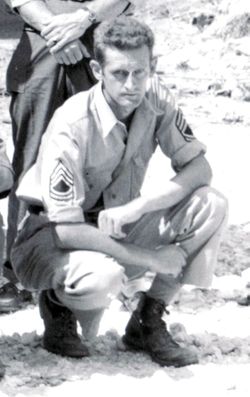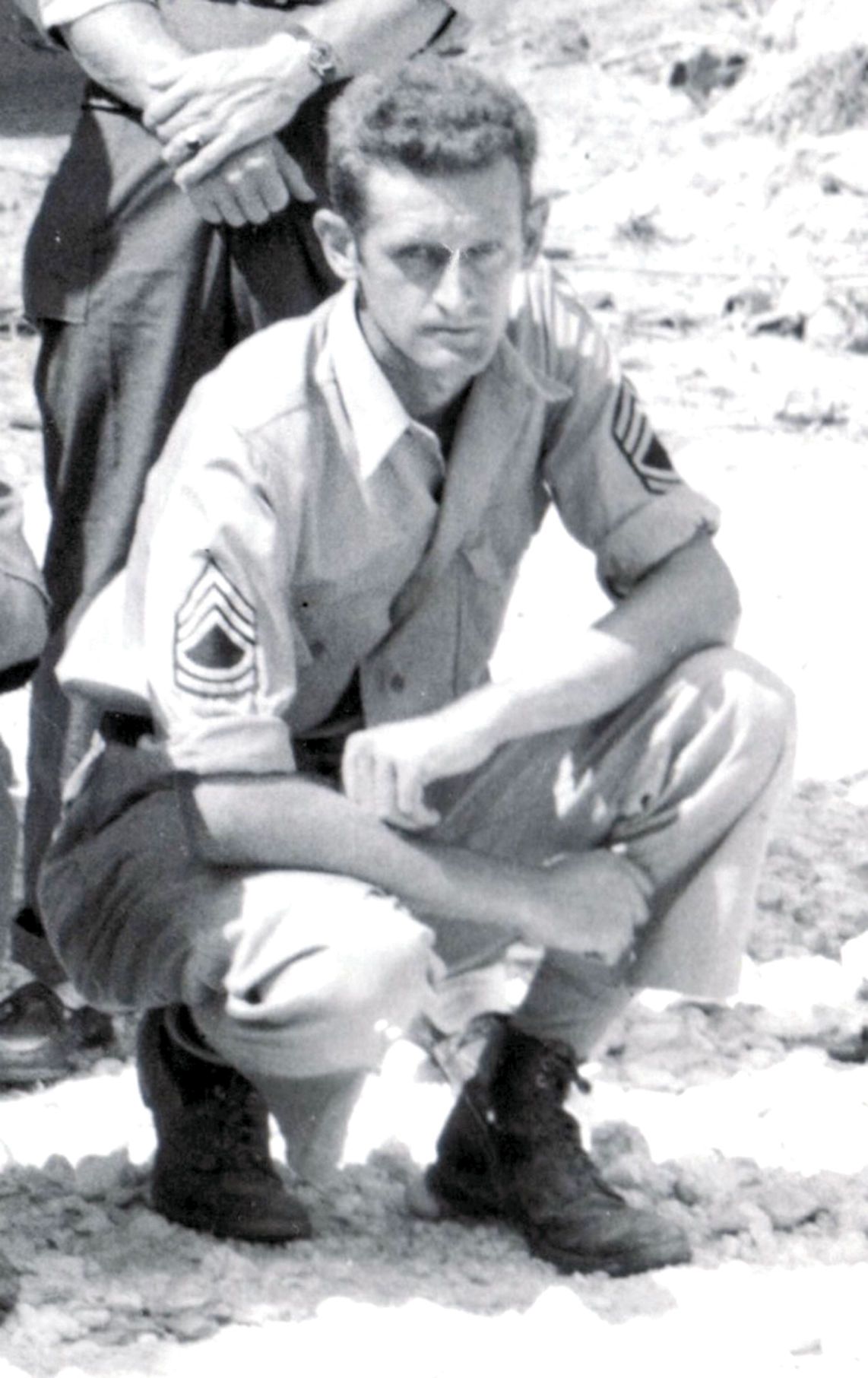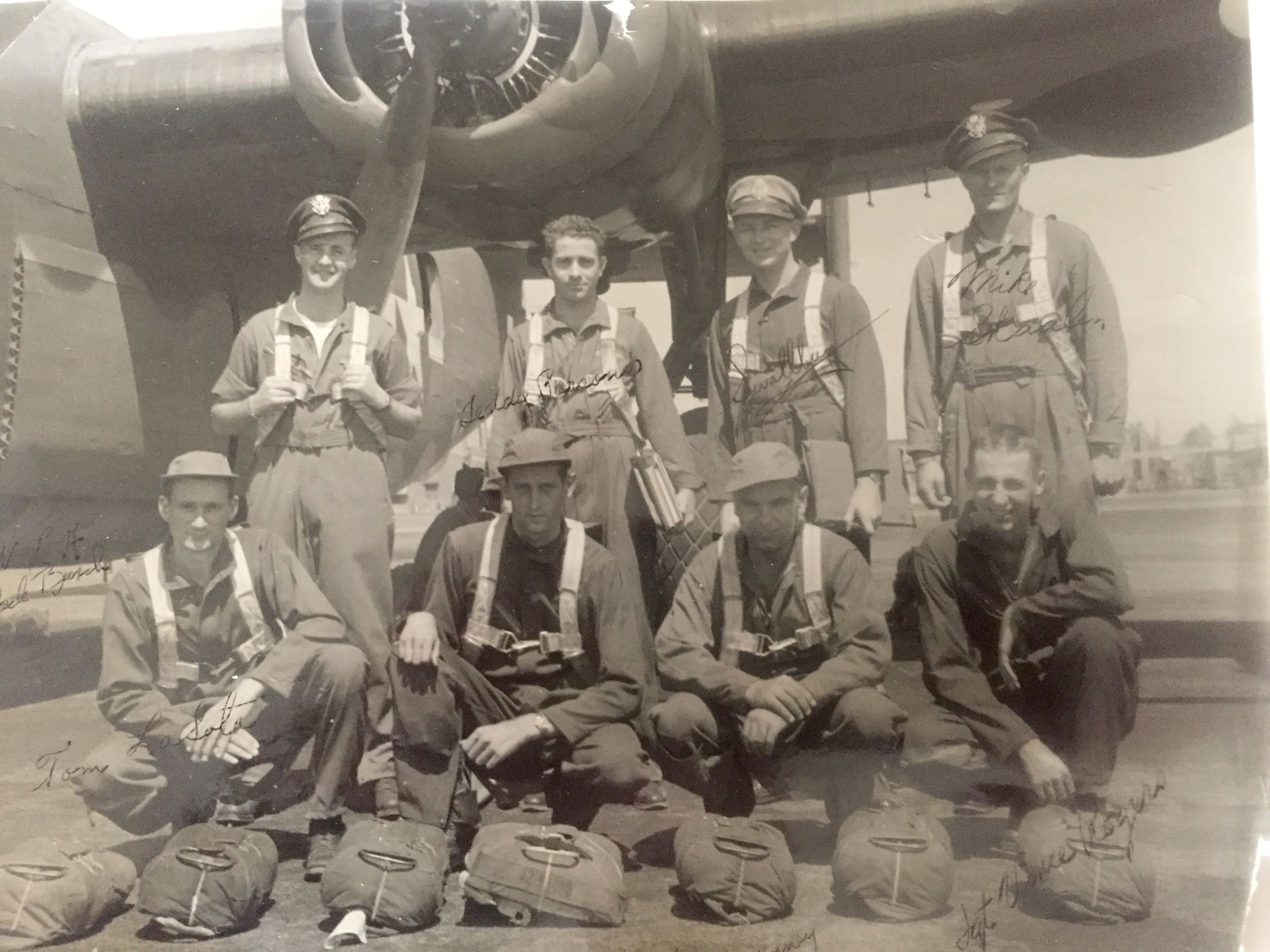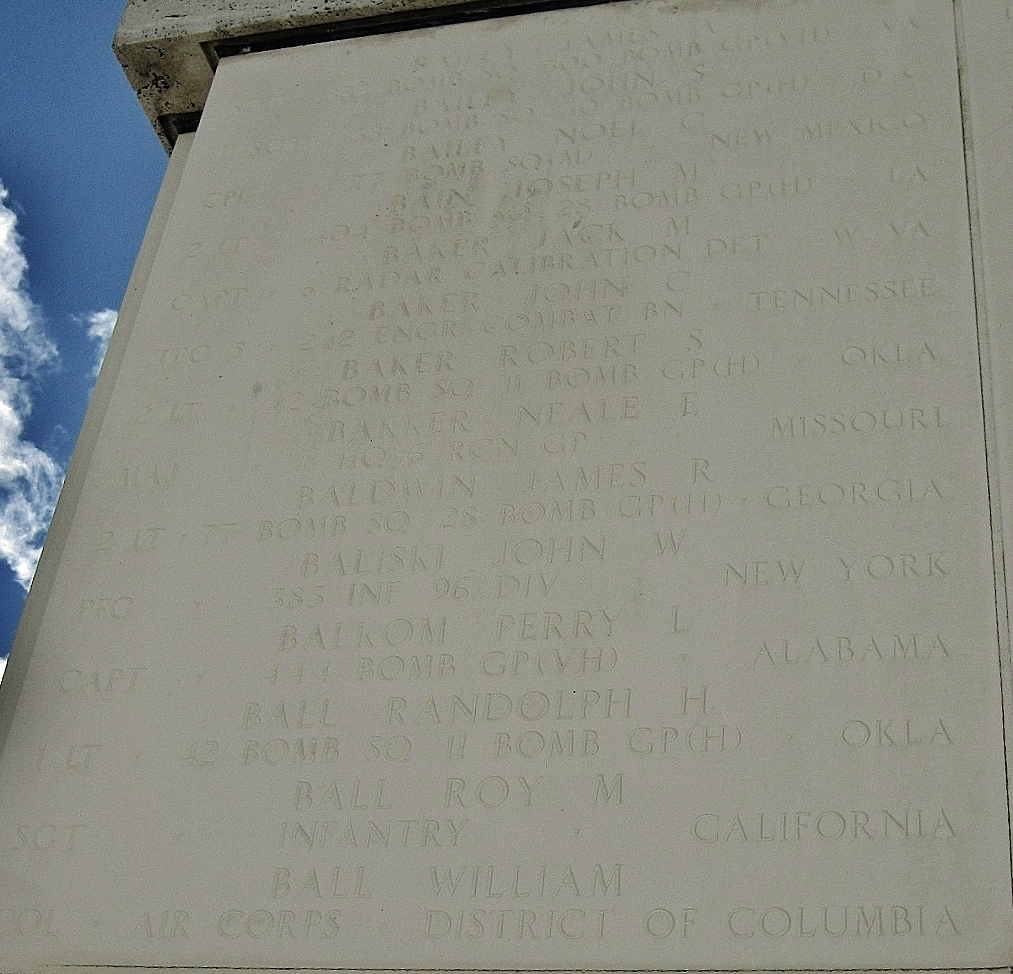~ ~ ~ ~ ~ ~
John served as a Technical Sergeant & Radio Operator on B-24J #42-72982, 38th Bomber Squadron, 30th Bomber Group, U.S. Army Air Force during World War II.
He resided in the District Of Columbia prior to the war.
He enlisted in the Army on May 21, 1942 at Fort Myer, Virginia. He was noted, at the time of his enlistment, as being employed as a Salesmen and also as Single, without dependents.
B-24J #42-72982 took off from Helen Island, Tarawa Atoll, Gilbert Islands on a combat mission. The pilot had trouble keeping altitude and the B-24 crashed shortly after take off.
John was declared "Missing In Action" in this crash during the war.
He was awarded the "Distinguished Flying Cross", Air Medal with 1 Oak Leaf Cluster, and the Purple Heart.
Service # 33190516
~ ~ ~ ~ ~ ~
Airmen who perished on B-24J #42-72982:
Bailey, John S ~ T/Sgt, Radio Operator, DC
Busch, Jack R ~ S/Sgt, Asst. Engineer, NY
Horney, Edward A ~ T/Sgt, Engineer, PA
LaSota, Thomas E ~ S/Sgt, Tail Gunner, MN
Rogers, Vincent J, Jr ~ S/Sgt, Asst. Radio, NY
Underwood, Donald E ~ 2nd Lt, Bombardier, MI
Van Vleet, George, Jr ~ Capt, Observer, CA
Airmen who survived from B-24J #42-72982:
Parsons, Theodore A ~ 2nd Lt, Navigator
Skaalen, Morris A ~ 1st Lt, Pilot
Swalberg, Carl A ~ 2nd Lt, Co-Pilot
Bio & Crew Report by: Russ Pickett
~~~~~~~~~~~~~~~~~~~~~~~~~~~~~~~
WINCHESTER Weve gathered to remember and give thanks for the life of Jack Bailey.
So began the Rev. Dan McCoig as he welcomed about 100 people attired in outfits ranging from suits and dresses to shorts and T-shirts to Wednesday afternoons graveside service for 28-year-old John S. Jack Bailey of Woodstock.
What made the service in Winchesters Mount Hebron Cemetery unique was that only about a dozen of its attendees were alive when Bailey died 74 years ago in a plane crash off the coast of a tiny island in the Pacific Ocean.
Bailey, a tech sergeant in the Army Air Forces during World War II, died along with six of his crew members Jan. 21, 1944, when their B-24J bomber, nicknamed Miss Bee Haven, slammed into shallow water shortly after takeoff from Hawkins Field on Betio Island in Tarawa atoll.
The planes pilot, co-pilot and navigator survived the crash. The bodies of Bailey and the other victims were recovered from the wreckage and buried on Betio, along with the remains of more than 1,200 Marines who had died two months earlier while capturing the island from Japanese forces.
Bailey was the only son of John Walter and Helen Solenberger Bailey of Winchester. Upon receiving news of his death, the parents placed a gravestone in the Solenberger family plot in Mount Hebron Cemetery and waited for their sons body to be returned after the war.
She was devastated that her son was killed, said 27-year-old Solenberger family descendant Jaime McManigle, who cried throughout Wednesdays service while thinking about Helen Baileys suffering.
In 1946 and 1947, the U.S. Department of Defense began the arduous process of recovering the remains of American servicemen buried on Betio Island. Due to incorrect mapping of burial areas, hundreds of bodies, including those of Bailey and three of his B-24J crew members, were not found.
Jack Baileys parents remained hopeful their son would eventually be returned, but they didnt live long enough to see it happen. Walter Bailey died in 1966 and Helen Bailey in 1983.
The nonprofit organization History Flight formed in the mid-2000s to find and recover the remains of all missing service members from Americas wars, including the four servicemen from Miss Bee Haven.
In May 2017, History Flight recovered human remains from underneath one of the hundreds of houses that had been built over the decades on Betio, which is now home to about 25,000 residents.
Scientists from the Defense Department used DNA to positively identify some of the remains as three of the four missing B-24J crew members Jack Bailey, 2nd Lt. Donald E. Underwood and Capt. George Van Vleet Jr.
While its possible that History Flight also recovered the remains of the fourth crewman, Staff Sgt. Vincent J. Rogers Jr., organization spokeswoman Katherine Rasdorf said he has not yet been positively identified by the Defense Department and is still considered missing.
Van Vleets remains have not been returned to the United States, but Underwood came home to Michigan on Nov. 20 and was subsequently buried in Arlington National Cemetery.
On Wednesday, Underwoods niece Joni Mehall and her husband, Mike Mehall, came from Michigan to pay their respects to Bailey.
We were just thrilled to come here and see another crew member, Joni Mehall said.
We want to see the whole crew, Mike Mehall added, noting he and his wife have already visited the final resting places of many of Miss Bee Havens crew. Now were waiting for Rogers and Van Vleet. Theyll be the last two.
Julie Sayre and her parents drove up from Saint Helena Island, S.C., to pay their respects to Jack Bailey. Sayres father, 92-year-old Stuart Bailey, was Jack Baileys cousin and his closest surviving relative.
He was about 10 years older than my dad, Sayre said of Jack Bailey, so he didnt really have a chance to know him very well.
I knew that he died in the war in the South Pacific, but thats all I knew, said Diane Kearns, owner of Fruit Hill Orchard in Frederick County and a member of the Solenberger family.
Jack Baileys casket was carried to his gravesite Wednesday by six Army soldiers in service uniforms. One of the soldiers stood watch next to the flag-draped coffin throughout the 15-minute memorial.
At the end of the service, two of the soldiers carefully folded the American flag from Jack Baileys casket and presented it to a solemn Stuart Bailey.
An Army honor guard team fired three volleys from three rifles, and a soldier played taps to honor their fallen brother.
Today he comes home, McCoig said.
~ ~ ~ ~ ~ ~
John served as a Technical Sergeant & Radio Operator on B-24J #42-72982, 38th Bomber Squadron, 30th Bomber Group, U.S. Army Air Force during World War II.
He resided in the District Of Columbia prior to the war.
He enlisted in the Army on May 21, 1942 at Fort Myer, Virginia. He was noted, at the time of his enlistment, as being employed as a Salesmen and also as Single, without dependents.
B-24J #42-72982 took off from Helen Island, Tarawa Atoll, Gilbert Islands on a combat mission. The pilot had trouble keeping altitude and the B-24 crashed shortly after take off.
John was declared "Missing In Action" in this crash during the war.
He was awarded the "Distinguished Flying Cross", Air Medal with 1 Oak Leaf Cluster, and the Purple Heart.
Service # 33190516
~ ~ ~ ~ ~ ~
Airmen who perished on B-24J #42-72982:
Bailey, John S ~ T/Sgt, Radio Operator, DC
Busch, Jack R ~ S/Sgt, Asst. Engineer, NY
Horney, Edward A ~ T/Sgt, Engineer, PA
LaSota, Thomas E ~ S/Sgt, Tail Gunner, MN
Rogers, Vincent J, Jr ~ S/Sgt, Asst. Radio, NY
Underwood, Donald E ~ 2nd Lt, Bombardier, MI
Van Vleet, George, Jr ~ Capt, Observer, CA
Airmen who survived from B-24J #42-72982:
Parsons, Theodore A ~ 2nd Lt, Navigator
Skaalen, Morris A ~ 1st Lt, Pilot
Swalberg, Carl A ~ 2nd Lt, Co-Pilot
Bio & Crew Report by: Russ Pickett
~~~~~~~~~~~~~~~~~~~~~~~~~~~~~~~
WINCHESTER Weve gathered to remember and give thanks for the life of Jack Bailey.
So began the Rev. Dan McCoig as he welcomed about 100 people attired in outfits ranging from suits and dresses to shorts and T-shirts to Wednesday afternoons graveside service for 28-year-old John S. Jack Bailey of Woodstock.
What made the service in Winchesters Mount Hebron Cemetery unique was that only about a dozen of its attendees were alive when Bailey died 74 years ago in a plane crash off the coast of a tiny island in the Pacific Ocean.
Bailey, a tech sergeant in the Army Air Forces during World War II, died along with six of his crew members Jan. 21, 1944, when their B-24J bomber, nicknamed Miss Bee Haven, slammed into shallow water shortly after takeoff from Hawkins Field on Betio Island in Tarawa atoll.
The planes pilot, co-pilot and navigator survived the crash. The bodies of Bailey and the other victims were recovered from the wreckage and buried on Betio, along with the remains of more than 1,200 Marines who had died two months earlier while capturing the island from Japanese forces.
Bailey was the only son of John Walter and Helen Solenberger Bailey of Winchester. Upon receiving news of his death, the parents placed a gravestone in the Solenberger family plot in Mount Hebron Cemetery and waited for their sons body to be returned after the war.
She was devastated that her son was killed, said 27-year-old Solenberger family descendant Jaime McManigle, who cried throughout Wednesdays service while thinking about Helen Baileys suffering.
In 1946 and 1947, the U.S. Department of Defense began the arduous process of recovering the remains of American servicemen buried on Betio Island. Due to incorrect mapping of burial areas, hundreds of bodies, including those of Bailey and three of his B-24J crew members, were not found.
Jack Baileys parents remained hopeful their son would eventually be returned, but they didnt live long enough to see it happen. Walter Bailey died in 1966 and Helen Bailey in 1983.
The nonprofit organization History Flight formed in the mid-2000s to find and recover the remains of all missing service members from Americas wars, including the four servicemen from Miss Bee Haven.
In May 2017, History Flight recovered human remains from underneath one of the hundreds of houses that had been built over the decades on Betio, which is now home to about 25,000 residents.
Scientists from the Defense Department used DNA to positively identify some of the remains as three of the four missing B-24J crew members Jack Bailey, 2nd Lt. Donald E. Underwood and Capt. George Van Vleet Jr.
While its possible that History Flight also recovered the remains of the fourth crewman, Staff Sgt. Vincent J. Rogers Jr., organization spokeswoman Katherine Rasdorf said he has not yet been positively identified by the Defense Department and is still considered missing.
Van Vleets remains have not been returned to the United States, but Underwood came home to Michigan on Nov. 20 and was subsequently buried in Arlington National Cemetery.
On Wednesday, Underwoods niece Joni Mehall and her husband, Mike Mehall, came from Michigan to pay their respects to Bailey.
We were just thrilled to come here and see another crew member, Joni Mehall said.
We want to see the whole crew, Mike Mehall added, noting he and his wife have already visited the final resting places of many of Miss Bee Havens crew. Now were waiting for Rogers and Van Vleet. Theyll be the last two.
Julie Sayre and her parents drove up from Saint Helena Island, S.C., to pay their respects to Jack Bailey. Sayres father, 92-year-old Stuart Bailey, was Jack Baileys cousin and his closest surviving relative.
He was about 10 years older than my dad, Sayre said of Jack Bailey, so he didnt really have a chance to know him very well.
I knew that he died in the war in the South Pacific, but thats all I knew, said Diane Kearns, owner of Fruit Hill Orchard in Frederick County and a member of the Solenberger family.
Jack Baileys casket was carried to his gravesite Wednesday by six Army soldiers in service uniforms. One of the soldiers stood watch next to the flag-draped coffin throughout the 15-minute memorial.
At the end of the service, two of the soldiers carefully folded the American flag from Jack Baileys casket and presented it to a solemn Stuart Bailey.
An Army honor guard team fired three volleys from three rifles, and a soldier played taps to honor their fallen brother.
Today he comes home, McCoig said.
Inscription
TSGT, US ARMY AIR FORCES WORLD WAR II
Family Members
Sponsored by Ancestry
Advertisement
Explore more
Sponsored by Ancestry
Advertisement








